THE NEW MADAGASCAR BORN IN ANOSY
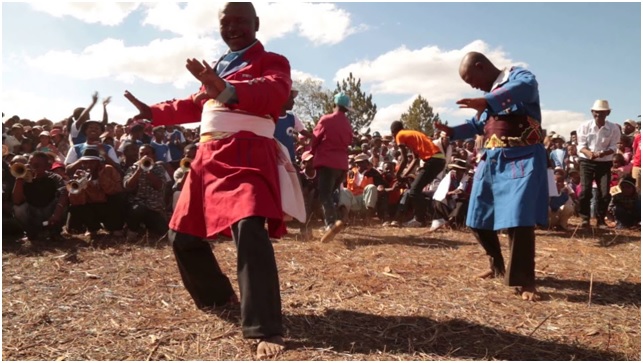
The war in Eastern Europe erases, in the perception of the individual, what is happening locally, in countries considered to be extremely neighbourly. Yet it is precisely in these countries that changes are taking place that are altering the history of the entire planet. In Africa, for example, conflicts are no longer resolved in the capital, but in distant and inaccessible areas, in which forces unknown to us fight where the only TV that arrives is that of Al Jazeera, the only media group still capable of representing the happenings of the internal world, and not only of the megacities.
To tell one of these stories, one needs the power of imagination. Imagine the fourth largest island in the world, in the heart of the Indian Ocean, a popular destination for many travellers eager for adventure and exoticism, in a land of endless coral reefs and nature parks[1] . It is home to 18 ethnic groups of ancient origin[2] , who arrived here some 2000 years ago and were then forced to defend themselves against the Portuguese invaders in the 16th century, who were looking for India and took the wrong route. They defended themselves well. It was only at the end of the 19th century that they were forced to surrender to the French, only to regain independence on 26 June 1960[3] , following struggles that began with the massacre of 29 March 1947[4] , perpetrated by the Malagasy Democratic Movement for Restructuring (MDRM)[5] .
Madagascar, like many islands, tends towards isolationism. The Malagasy are proud of their national identity[6] , consecrated every year in the musical and warrior festival of Hiragasy[7] , with its myths and legends handed down from generation to generation, held on a plateau south of the capital Antananarivo, on the shores of Lake Anosy. Madagascar’s is a peasant aristocracy, whose first president, Philibert Tsiranana[8] , a high school teacher born into a family of cattle breeders of the Tsimihety ethnic group[9] , was ousted by the 1975 coup d’état of Didier Ratsiraka[10] , a Merina nobleman who remained in office until the deep economic crisis, in 1991, caused him to flee[11] ; A few years later, he regained control of the country, until the 2001 elections[12] , won by Marc Ravalomanana[13] of the Merina ethnic group[14] , a former itinerant yoghurt seller, who with courage and obstinacy built a business empire.
An economy that does not start
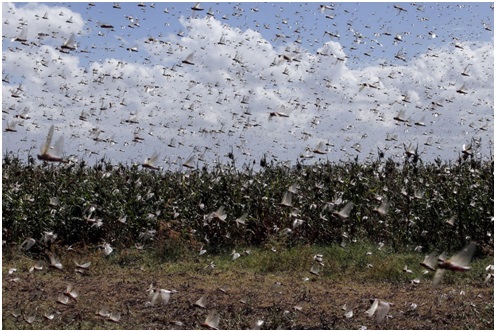
Locusts attack a cereal field: within seconds everything is destroyed[15]
In order to get the country off the ground, Ravalomanana relies on multinational corporations: he cedes the usufruct of almost a third of the country’s agricultural land to the Koreans of Daewoo[16] for the cultivation of plants for the production of biofuels[17] . The people protest, the president sends in the army, but this solidarises with the protesters and leads, in the following elections, to a complete defeat of the outgoing president and the beginning of the era of President Rajoelina. A defeat that rests its foundations on religious confrontation within Malagasy society: Ravalomanana is Catholic, Rajoelina is a nobleman of the Merina ethnic group[18] , which is organised in the FFKM (Council of Christian Churches of Madagascar)[19] – half party, half religious organisation, of Protestant faith, with very strong roots in English Freemasonry[20] .
Among the provinces of Madagascar, the most important is the one centred around Lake Anosy, the country’s most important lake, also because it includes the capital Antananarivo[21] , which the Malagasy call Tanà: founded in the 17th century, the city stands on a hill on which the Royal Estate, a monument built by the kings of the Imerina, stands out[22] . The province is in the south and reaches as far as the largest mining port, Fort Dauphine[23] , and in recent years has been in the eye of the storm because of its dramatic environmental and social situation: the village of Vohitelo, renamed ‘zombie village’, is now inhabited only by people ravaged by hunger and thirst, who wander aimlessly and in a semi-confused state through the dusty streets.
Drought has been chronic in these territories for centuries, but it is not the only one to destroy crops: Madagascar also fights against the cyclical arrival of entire platoons of locusts and grasshoppers[24] that devastate thousands of hectares of crops[25] , consuming, in a few minutes, what humanity 2500 people eat in a week. For them, Madagascar has an optimal environment: the summer climate is very humid and torrid[26] accompanied by heavy rains from October until spring, and the insects manage to reproduce every two months. We are now in the fifth generation, and the country does not have the necessary quantities of pesticides. The FAO believes that more than $15 million is needed to carry out a serious and targeted soil and air control campaign on a total territory of about 500,000 hectares, which the Malagasy government is unable to support[27] .
Therefore, in some agricultural and rural areas, people have organised themselves by integrating grasshoppers as food[28] by catching them with special nets or by hand; they are then drowned in bowls of water, dried in the sun and eaten fried or roasted. No contraindications, says the FAO, unless they have ingested pesticides dangerous to humans. But locusts are not everything: far more serious and lasting effects arise from pollution caused by mining[29] and deforestation[30] .
The case of Qit Madagascar Minerals (QMM)[31] , the local subsidiary of the multinational Rio Tinto, is only the latest in a long list: this mining giant is all over the pages of the local newspapers because it has agreed to compensate some communities in the villages around Taolagnaro (south-eastern Madagascar) for water pollution caused by the activity of the mining factories – not only for the effects on the fields, but also for the death of fish in the adjacent sea[32] . The situation is explosive: many are protesting, even violently, against the multinationals that are devastating flora and fauna with chemical processes[33] .
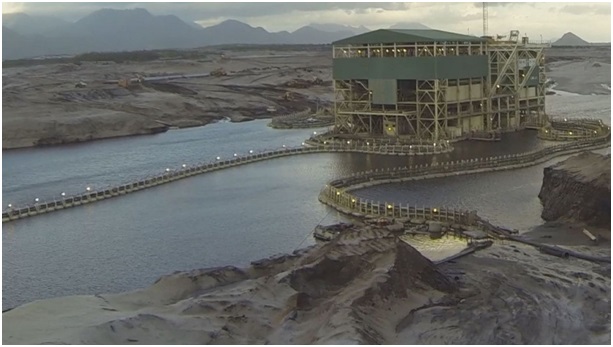
Kilometres of rainforest turned into a moon land by the Rio Tinto group’s QMM mine[34]
Pollution is proceeding in parallel with the deforestation of the island[35] : in 2010, Madagascar had approximately 16.4 thousand hectares of forest, covering more than 28% of its surface area, and by 2021 it had lost approximately 235,000 hectares of forest, equivalent to 119 cubic metres of CO2 . From 2002 to 2021, Madagascar lost 949,000 hectares of rainforest[36] . With it, a unique fauna will also disappear[37] . This is so serious that it has inspired dozens of studies by NGOs and universities around the world[38] .
Local farmers are also to blame, and the practice of ‘tavy’[39] : setting fire to vegetation after it has been, cut down, creating optimal soil for the cultivation of rice plantations. Although it has been illegal since 1987[40] , it continues to be practised because hardly anyone is prosecuted for it. The government turns a blind eye, so that almost 90% of the Malagasy population relies on biomass for its energy needs. It is estimated that Madagascar’s forests could disappear within 25 years if deforestation continues at current levels[41] , and several researchers predict that 38-93% of the forests present in 2000 could disappear by 2050.
All this destruction is not accompanied by an increase in per capita wealth, as Madagascar remains among the poorest countries in the world[42] , not surprisingly plagued by constant protests and acts of vandalism. Economist Mark Stocker[43] , in his study for the World Bank, states that ‘a commitment by the government to implement bold reforms to stimulate private investment and job creation, improve public sector governance and strengthen resilience to shocks has become all the more urgent as Madagascar faces new headwinds’[44] .
Despite a tentative recovery in 2019, the pandemic[45] – which has affected Madagascar much less than the rest of the continent – has been complicit in a recession about three times deeper than in the rest of sub-Saharan Africa, with exports and private investments plummeting by 7.1% and per capita income by 9.8%. Scholars calculate that by 2020, some 1.8 million more inhabitants will have fallen below the international poverty line, which has reached an all-time high of 80.7 per cent[46] . This means higher unemployment, a decrease in public services (education, health, transport, army), delayed payment of stupends and a general decline in tax revenues. All this, combined with drought, deforestation and pollution, delivers us a Madagascar in disarray.
In this sense, there is no perceived difference between the Protestant government of Andry Nirina Rajoelina[47] , elected on 17 March 2009[48] by an army decision to quell popular protests[49] , and the resigning government of the Catholic Marc Ravalomanana[50] . In less than a year’s time there will be a vote, and there are again only the two of them as candidates[51] . Nothing will change, at least on the surface. But that is not the case. Society is changing, which is why Rajoelina, year of birth 1984[52] , son of an army colonel[53] , has risen through politics to become president. First an organiser and promoter of events[54] , then a media entrepreneur with Injet and Domapub (when only 15 years old)[55] , then a DJ and owner of Viva Tv[56] .
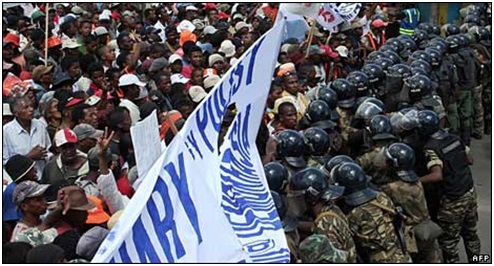
February 2009: People attack the army during election rallies in Antananarivo[57]
In 2007, he became Mayor of Antananarivo[58] , and he did so with such a result that he put fear into Ravalomanana[59] , the Protestant Catholic President of Imerikasina[60] , who had supported him until then, while he took care of his own dairy industry, TIKO, the country’s largest and most important company[61] . When the people revolted against President[62] in 2009, Rajoelina supported the protesters, accusing the government of misappropriation of funds, using the media at his disposal[63] . A military group organises the coup[64] and Rajoelina is appointed President of the High Transitional Authority of Madagascar[65] . In 2014, a vote is held. Rajoelina cannot run for constitutional reasons[66] , so he endorses Hery Rajaonarimampianina[67] , an economist, who wins the election. On 7 September 2018, he resigned[68] , paving the way for Rajoelina to run again.
In 2018, Rajoelina came to the ballot together with 47 other candidates (including Marc Ravalomanana) [69] : in the second ballot Rajoelina prevailed with 55.1% of the vote[70] . Shortly afterwards Madagascar was overwhelmed by the famine of 2021, which affected one million of the nation’s inhabitants[71] , and in the same year Rajoelina was the victim of an assassination attempt[72] . In 2022, Cyclone Batsira swept over the island, displacing some 120,000 people and destroying 124,000 houses[73] . The government in Rajoelina is criticised for spending funds in a superficial manner (sports stadiums and useless facilities)[74] . And here we are back to square one. Officially, the political proposal has not changed – it is non-existent. The decision is mainly in the hands of the churches: the FJKM – the Church of Jesus Christ in Madagascar[75] , the largest Christian Church in Madagascar, supports Ravalomanana (former Vice-President of the association). The FFKM, on the other hand – Ecumenical Council of Churches of Madagascar[76] openly supports Rajoelina[77] .
And then there are the trade unions. They work, and they really fight for the workers. It was just a few weeks ago that the Industrial Global Union[78] , which has a presence in about 100 countries around the world and is very strong in Madagascar, intervened in favour of the release of Sento Chang, a worker unjustly imprisoned for writing a critical social media post about his company[79] . International organisations have invested a lot in the island (such as the ITUC International Unione Trade Confederation[80] , the USAM Union des Syndicats Autonomes des Madagascar[81] and the SEKRIMA Christian Confederation of Malagasy Trade Unions[82] ) and the population, waiting for effective multi-partyism, discusses trade unionism.
In 2009, during Rajoelina’s first government, it was the international trade union movement ITUC that launched a strong call for the resolution of the social emergency in Madagascar[83] that resonated in the media worldwide, giving President Rajoelina a hard time. From then on, the government created a direct line with some leading trade unionists at the local level, who became effective (and efficient) spokespersons of popular discontent and mediators between the grassroots and the top of the Madagascan state[84] .
The Dahalos
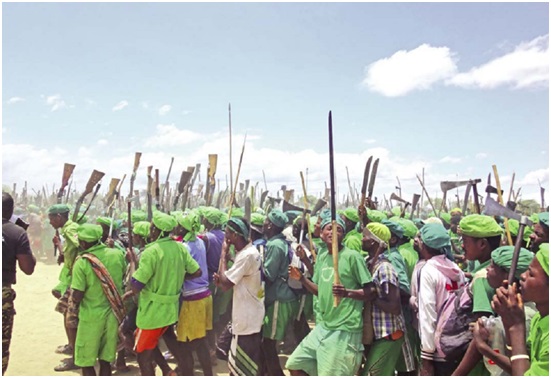
The Dahalo, cattle thieves who have grown into rebel troops with guns, shovels and pitchforks control the north of Anosy province[85]
So far we have told of the more or less organised forces that command or channel dissent. Then there is the rest, which is what is new, at least in part – starting with those who, a hundred years ago, were dispossessed, who had been driven out of their villages and by the army, and who live by stealing cattle: they are a Malagasy tradition, they are called Dahalo – the bandits[86] . Over the years, they have given themselves a structure and an organisation, and today they are part of the groups that knock on the door of power and ask to be invited to the negotiating table[87] : their photos and video testimonies do not stop flooding social networks and the internet . [88]
They are not an ethnic group, they do not adhere to a political model or ideology, they are not necessarily hostile to the government, they are not secessionists. They are street bandits, people who have banded together out of need, who have armed themselves by robbing army barracks, or simply because many soldiers, after months without receiving their salaries, have taken their weapons with them and joined the Dahalos, stealing herds, hiding them in the most impregnable areas of the forest, stealing food and petrol, or earning money by kidnapping[89] . If anyone resists, like the village of Ilambohazo in the Anosy region, they attack, six people, put the village to the sword, and force the inhabitants to flee[90] .
In 2012, in a single raid, the Dahalos stole around 900 zebu and disappeared, camouflaging themselves in the jungle. They have no leader, and when they have enough food they are almost part of the local folklore. When, in 2022, Madagascar was confronted with tropical cyclone Batsirai[91] and, a few months later, cyclone Freddy[92] , swept over the country, the Dahalos returned to the wild, because they are hungry. They are barricaded in the jungle, too. They too are in the province of Anosy, in the inaccessible district of Betroka, where there are the Andriry Mountains, more than a hundred kilometres from the nearest town, and where the United Nations, since 2017, has been trying to restore peace, delivering food, petrol and medicine[93] .
No mission of the ‘blue helmets’ is decided, but the maintenance of order in the province of Anosy is delegated to the regular army, which carries it out in the expected manner: violence, repression, blackmail, intimidation[94] . After the outbreak of the pandemic, the economic crisis brought with it the fact that the soldiers’ salaries were paid more and more sporadically, and that the units stationed in the province of Anosy were therefore no longer able to guarantee order, even with violence – which is why, since the beginning of the war in Ukraine, the Dahalos have been laying down the law in this province, and, for some months now, the Russian army and mercenary groups linked to President Putin[95] .
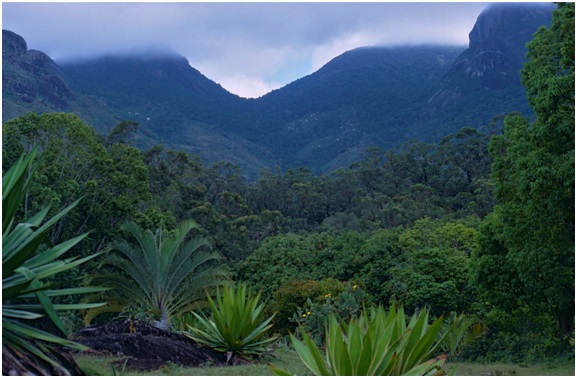
The mountainous area of Anosy province, where the Dahalo and troops who have turned their backs on the Malagasy regular army are hiding[96]
For the past six months, it is impossible to understand what is happening in the entire province of Anosy. The stories arriving in the capital are fragmentary, those arriving at the port of Fort Dauphine are influenced by the fact that they come from areas that can no longer be travelled on normal roads, roads that lead to areas where no one wants to go and, for this reason, have not been treated for years. The state no longer knows who lives in a district almost as big as Albania. What is known, and this is new, is that the mines not only rely on private security services, but that they have now made agreements with inconvenient neighbours who, fortunately, have no ambitions of territorial conquest, but are simply ascended where they let them survive, where no one hunts them anymore.
Anosy resembles, in some ways, Transnistria[97] , a territory situated between Romania and Moldova, not recognised by the other states, about which nothing is known, because it is practically forbidden to go there. In Anosy, there are no prohibitions, because there is no state, starting with the registry services. There is nothing to resemble an administration, and the armed groups that populate it have no ambition to become a state themselves. In this vacuum, important industrial and military activities take place beyond world control, they are no longer even registered. At the borders of this area, one can see the consequences, which are very serious, on the people and the environment, but not even the United Nations can think of sending someone down there to try to understand.
On top of that, presidential elections are approaching with candidates with no proposals for change, no ideological proclamations, only religious issues that we already know will lead to armed clashes between factions. How will Anosy vote? He will not vote, of course. In the jumble of dystopian futures thought up by novelists, the one in Madagascar is a special case: the end of a society, in a situation where part of humanity survives, somehow. And we know nothing.
SVE018
[1] https://www.roadtripafrica.com/madagascar/itinerary
[2] https://www.cipsi.it/wp-content/uploads/2021/12/2021-12-copertina-convertito-LA-VITA-PER-TE.pdf
[3] https://www.cocolodgemajunga-madagascar.com/it/joyeuse-fete-de-lindependance-a-tous-les-malagasy/
[4] https://malagasy.it/it/29-marzo-1947-insurrezione-anti-francese-a-madagascar
[5] https://www.iris.unina.it/retrieve/handle/11588/534710/8955/La%20democrazia%20nel%20Madacascar0.pdf
[6] https://rove.me/it/to/madagascar/independence-day
[7] Didier Mauro, ” Madagascar, l’opéra du peuple: anthropologie d’un fait social total: l’art Hira Gasy entre tradition et rébellion ” Paris, KARTHALA Editions, 2001
[8] https://www.blackpast.org/global-african-history/people-global-african-history/philibert-tsiranana-1912-1978/
[9] https://www.locoloconavy.com/secrets-roots/etnie/
[10] https://www.jstor.org/stable/161749
[11] https://www.rivistamissioniconsolata.it/2009/04/01/nella-terra-dei-lemuri/
[12] http://documenti.camera.it/leg16/dossier/testi/ES1270paese.htm
[13] https://www.britannica.com/biography/Marc-Ravalomanana
[14] https://www.madainitaly.com/il-madagascar/popolazioni-del-madagascar/
[15] https://slate.com/technology/2021/07/grasshoppers-drought-farming-west-swarms.html
[16] https://ejatlas.org/conflict/daewoo-maize-and-biofuel-project-madagascar
[17] https://www.vita.it/it/article/2009/02/13/e-la-daewoo-si-compero-un-ottavo-di-madagascar/86192/
[18] https://dial.ird.fr/wp-content/uploads/2021/10/2018-06-Elites-in-Madagascar-a-sociography.pdf
[19] https://bti-project.org/en/reports/country-report/MDG
[20] William A. Shack; Elliott P. Skinner (1979). Strangers in African Societies. University of California Press. pp. 222-223
[21] https://www.britannica.com/place/Antananarivo
[22] https://www.jstor.org/stable/1801521
[23] https://stream24.ilsole24ore.com/video/mondo/in-madagascar-carestia-e-siccita-villaggio-zoombie/AEqvsuY?refresh_ce=1
[24] https://www.regionieambiente.it/locuste-emergenza/
[25] https://gd.eppo.int/taxon/LOCUMC
[26] https://climateknowledgeportal.worldbank.org/country/madagascar/climate-data-historical#:~:text=In%20Madagascar%2C%20two%20seasons%20are,maximum%20of%203%2C700%20mm%20annually .
[27] https://www.fao.org/ag/locusts/en/info/2085/index.html
[28] https://www.independent.co.uk/climate-change/news/madagascar-locusts-famine-climate-change-b1908448.html
[29] http://country.eiu.com/article.aspx?articleid=1252151108&Country=Madagascar&topic=Economy&subtopic=Forecast&subsubtopic=Policy+trends&u=1&pid=247143608&oid=247143608
[30] https://www.globalforestwatch.org/dashboards/country/MDG/
[31] https://www.riotinto.com/operations/madagascar/qit-madagascar-minerals
[32] https://www.business-humanrights.org/en/latest-news/madagascar-fishermen-women-protesting-qmm-mining-clash-with-police-two-spokepersons-arrested-and-beaten-in-custody/ ; https://www.reuters.com/markets/commodities/rio-tintos-madagascar-mine-restarts-after-reaching-deal-with-protesters-2022-05-24/ ; https://news.mongabay.com/2023/05/fish-deaths-near-rio-tinto-mine-in-madagascar-dredge-up-community-grievances/
[33] https://www.theguardian.com/environment/2022/mar/09/ambatovy-the-madagascan-mine-that-might-prove-carbon-offsetting-works-aoe
[34] https://it.euronews.com/next/2016/09/08/colossi-minerari-in-madagascar
[35] https://www.globalforestwatch.org/dashboards/country/MDG/?category=summary&location=WyJjb3VudHJ5IiwiTURHIl0%3D&map=eyJjZW50ZXIiOnsibGF0IjotMTguOTE4MDU2OTIyMjY3NDE4LCJsbmciOjQ2Ljg0NTU1NDM1NTAxNTgyfSwiem9vbSI6NC42NzM2ODEzOTM4NDc0NzgsImNhbkJvdW5kIjpmYWxzZSwiZGF0YXNldHMiOlt7ImRhdGFzZXQiOiJwb2xpdGljYWwtYm91bmRhcmllcyIsImxheWVycyI6WyJkaXNwdXRlZC1wb2xpdGljYWwtYm91bmRhcmllcyIsInBvbGl0aWNhbC1ib3VuZGFyaWVzIl0sImJvdW5kYXJ5Ijp0cnVlLCJvcGFjaXR5IjoxLCJ2aXNpYmlsaXR5Ijp0cnVlfSx7ImRhdGFzZXQiOiJOZXQtQ2hhbmdlLVNUQUdJTkciLCJsYXllcnMiOlsiZm9yZXN0LW5ldC1jaGFuZ2UiXSwib3BhY2l0eSI6MSwidmlzaWJpbGl0eSI6dHJ1ZSwicGFyYW1zIjp7InZpc2liaWxpdHkiOnRydWUsImFkbV9sZXZlbCI6ImFkbTAifX1dfQ%3D%3D&showMap=true
[36] https://www.sciencedirect.com/science/article/pii/S2351989423000240
[37] https://www.wwf.ch/it/dove-operiamo/madagascar-un-paradiso-della-biodiversita
[38] https://www.afrik21.africa/en/madagascar-the-government-denounced-for-its-inaction-against-deforestat ion/
[39] https://www.evaneos.co.uk/madagascar/holidays/discover/975-1-deforestation-in-madagascar/
[40] https://news.mongabay.com/2017/11/to-feed-a-growing-population-farms-chew-away-at-madagascars-forests/#:~:text=In%20Madagascar%2C%20farmers%20are%20cutting,extinction%20two%20to%20forest%20loss .
[41] https://www.nationalgeographic.com/environment/article/madagascar-baobab-trees-deforestation-climate-change
[42] https://www.worldbank.org/en/country/madagascar/publication/madagascar-economic-update-navigating-through-the-storm-a-new-drive-for-reforms-in-madagascar-is-crucial
[43] https://cepr.org/about/people/marc-stocker
[44] https://www.worldbank.org/en/country/madagascar/publication/madagascar-economic-update-navigating-through-the-storm-a-new-drive-for-reforms-in-madagascar-is-crucial
[45] https://reliefweb.int/report/madagascar/madagascar-economic-update-navigating-through-storm
[46] https://reliefweb.int/report/madagascar/madagascar-economic-update-navigating-through-storm
[47] https://www.blackpast.org/global-african-history/andry-rajoelina-1974/
[48] https://www.reuters.com/article/madagascar-crisis-idUSLDE5BG0BT20091217
[49] https://www.nigrizia.it/notizia/madagascar-il-golpe-e-legale
[50] https://www.theguardian.com/world/2009/mar/17/madagascar-president-ravalomanana-resigns
[51] https://en.wikipedia.org/wiki/2023_Malagasy_presidential_election
[52] https://madagascar-tourisme.com/en/discover/the-highlands/antsirabe/
[53] https://www.myheritage.it/research/collection-10182/riassunti-biografici-di-persone-celebri?itemId=2850140&action=showRecord
[54] https://www.emerald.com/insight/content/doi/10.1108/OXAN-DB273134/full/html
[55] https://www.africaintelligence.com/southern-africa-and-islands/2021/03/05/president-rajoelina-s-clique-of-trusted-advisors,109648231-ar2
[56] https://rsf.org/en/government-closes-tv-station-owned-political-rival
[57] http://news.bbc.co.uk/2/hi/africa/7935682.stm
[58] https://www.france24.com/en/20090131-antananarivo-mayor-says-he-charge-country –
[59] https://www.britannica.com/biography/Marc-Ravalomanana
[60] https://www.vtt.mg/portfolio/imerikasina-anjeva-imerintsihadino-tombeau-samuel-rakotondrabe/
[61] https://www.britannica.com/topic/TIKO-Madagascan-company
[62] https://www.reuters.com/article/madagascar-politics-idUKLR94331020090327
[63] https://www.aljazeera.com/news/2010/11/20/timeline-madagascar-crisis
[64] https://reliefweb.int/report/madagascar/madagascar-coup-plot-stokes-pressure-rajoelina
[65] https://www.globalsecurity.org/military/world/africa/ma-pres-rajoelina.htm
[66] https://www.dw.com/en/madagascars-former-finance-minister-declared-winner-in-presidential-election/a-17369556
[67] https://www.lesrencontreseconomiques.fr/2018/en/speakers/hery-rajaonarimampianina/
[68] https://www.africarivista.it/madagascar-il-presidente-si-e-dimesso/128681/
[69] https://www.aljazeera.com/news/2018/11/6/madagascar-presidential-election-what-you-need-to-know
[70] https://www.aljazeera.com/news/2018/12/27/ex-president-rajoelina-wins-madagascar-vote-election-commission
[71] https://news.un.org/en/story/2021/11/1106132
[72] https://www.bbc.com/news/world-africa-58050276
[73] https://reliefweb.int/disaster/tc-2022-000160-mdg
[74] https://www.africaintelligence.com/southern-africa-and-islands/2022/04/13/andry-rajoelina-s-centralised-style-of-government-comes-under-fire-from-his-own-majority,109767691-art
[75] https://www.oikoumene.org/member-churches/church-of-jesus-christ-in-madagascar-fjkm
[76] https://lejournaldelafrique.com/en/in-madagascar-can-the-ffkm-ease-electoral-tensions/
[77] https://blogs.lse.ac.uk/africaatlse/2020/07/10/in-madagascar-religions-play-a-key-role-in-peace-and-conflict-processes/
[78] https://www.industriall-union.org/affiliates/madagascar
[79] https://www.industriall-union.org/unions-intensify-demands-for-release-of-madagascar-trade-unionist
[80] https://www.ituc-csi.org/madagascar?lang=en ; https://www.ituc-africa.org/+-Madagascar-+.html?lang=en
[81] https://www.ilo.org/dyn/normlex/en/f?p=1000:14101:::NO:14101:P14101_COUNTRY_ID,P14101_ARTICLE_NO:102955,22
[82] https://survey.ituc-csi.org/Madagascar.html?lang=en
[83] https://www.ituc-csi.org/madagascar-call-for-a-lasting?lang=en
[84] https://www.madagascar-tribune.com/Le-collectif-Tany-denonce-des-violations-des-droits-des-prevenus.html ; https://www.business-humanrights.org/fr/derni%C3%A8res-actualit%C3%A9s/eug%C3%A8ne-chretien-ratovondrainy-association-fikambananny-p%C3%AAcheur-fpe/ ; https://www.rfi.fr/fr/afrique/20220501-madagascar-tensions-et-n%C3%A9gociations-entre-qmm-et-les-riverains-de-fort-dauphin
[85] https://lexpress.mg/26/05/2021/insecurite-une-mafia-derriere-les-dahalo/
[86] https://digitalcollections.sit.edu/isp_collection/69/ ; https://storyteller.iom.int/stories/building-peace-madagascars-stronghold-cattle-thieves
[87] https://lexpress.mg/26/05/2021/insecurite-une-mafia-derriere-les-dahalo/
[88] https://storyteller.iom.int/stories/building-peace-madagascars-stronghold-cattle-thieves ; https://www.youtube.com/watch?v=8HFFP0gLB2U
[89] https://reliefweb.int/map/madagascar/madagascar-dahalo-attack-displaces-people-south-situation-update-15-june-2012
[90] https://reliefweb.int/report/madagascar/analysis-madagascars-unforgiving-bandit-lands
[91] https://greenreport.it/news/clima/madagascar-il-ciclone-batsirai-ha-fatto-almeno-21-morti-e-danni-devastanti/
[92] https://www.repubblica.it/solidarieta/emergenza/2023/03/24/news/madagascar_malawi_e_mozambico_il_ciclone_freddy_ha_distrutto_infrastrutture_esponendo_le_popolazioni_a_rischi_per_la_salute-393486349/
[93] https://storyteller.iom.int/stories/building-peace-madagascars-stronghold-cattle-thieves
[94] https://reliefweb.int/report/madagascar/madagascar-les-forces-arm-es-brutalisent-et-ex-cutent-sommairement-la-population ; https://imazpress.com/evenements/larmee-tire-sur-la-foule-des-dizaines-de-morts
[95] https://www.dcaf.ch/sites/default/files/publications/documents/madagascar_study.pdf ; https://www.rfi.fr/fr/afrique/20221020-madagascar-russie-entente-cordiale-cooperation-militaire-iles-eparses-wagner ; https://storyteller.iom.int/stories/building-peace-madagascars-stronghold-cattle-thieves
[96] https://en.wikipedia.org/wiki/Anosy#/media/File:Pic_Saint-Louis_(9592460866).jpg
[97] THE MOLDAVIA OF THE OLIGARCHI, WHERE THE MIDDLE AGE IS MORE ALIVE THAN EVER | IBI World Italy

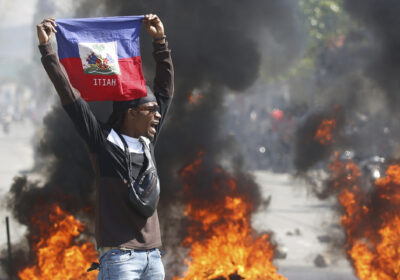
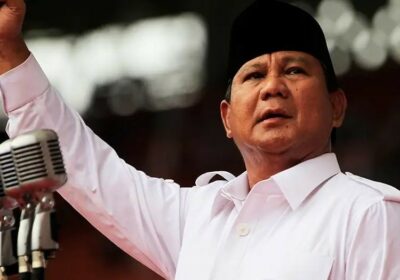
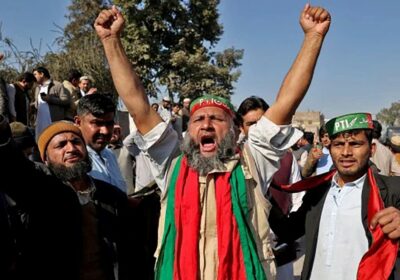
Leave a Reply